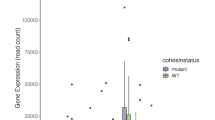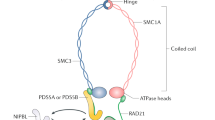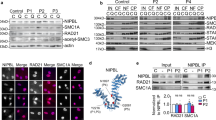Abstract
Cohesins appear to have critical functions beyond mitotic cohesion. Our data on a cohesin-associated Pds5-paralog, APRIN, indicate a novel cohesin role in stem cell differentiation. APRIN/Pds5B is lost in many cancers and it is a putative tumor suppressor. Its mutations in the germ line, however, generate birth defects. We reasoned that as both cancer and birth defects share disrupted stem cell differentiation, the data suggest an APRIN/Pds5B cohesin function in stem cells. We used an embryonal carcinoma stem cell model and show here that (i) APRIN expression is precisely coordinated with stem cell differentiation; (ii) this coordination involves surface-contact and endocrine pathways; and (iii) APRIN/Pds5b coordination is critical in stem/progenitor exit decisions. APRIN knockdown disrupted Oct4, Nanog and SOX2 patterns, differentiation failed and the resulting immature proliferative cells did not progress beyond proneural progenitor phase. Furthermore, the phenotype—blocked progenitor exit (Mash-1+); failed E-cadherin exit (E-Cadhlow+); incomplete N-cadherin transition (N-Cadhlow+); retained proliferative capacity (c-myc+); irregular stemness (SOX2late++) and lost response to contact and hormonal cues—shares similarities with cancer-initiating cells. The data suggest novel APRIN/Pds5B-linked cohesin roles in stem/progenitor programs and a new mechanism in tumor suppression.
This is a preview of subscription content, access via your institution
Access options
Subscribe to this journal
Receive 50 print issues and online access
$259.00 per year
only $5.18 per issue
Buy this article
- Purchase on Springer Link
- Instant access to full article PDF
Prices may be subject to local taxes which are calculated during checkout




Similar content being viewed by others
References
Ailles L, Weissman I . (2007). Cancer stem cells in solid tumors. Curr Opin Biotechnol 18: 460–466.
Aravind L, Landsman D . (1998). AT-hook motifs identified in a wide variety of DNA-binding proteins. Nucleic Acids Res 26: 4413–4421.
Bain G, Ray W, Yao M, Gottlieb D . (1994). From embryonal carcinoma cells to neurons: the P19 pathway. Bioessays 16: 343–348.
Berney C, Pawlowski J . (2006). A molecular time-scale for eukaryote evolution recalibrated with the continuous microfossil record. Proc Biol Sci 273: 1867–1872.
Cattaruzzi G, Altamura S, Tessari M, Rustighi A, Giancotti V, Pucillo C et al. (2007). The second AT-hook of the architectural transcription factor HMGA2 is determinant for nuclear localization and function. Nucleic Acids Res 35: 1751–1760.
DuVall G, Walden D . (1996). Adenocarcinoma of the esophagus complicating Cornelia de Lange syndrome. J Clin Gastroenterol 22: 131–133.
Gao X, Bian W, Yang J, Tang K, Kitani H, Atsumi T et al. (2001). A role of N-cadherin in neuronal differentiation of embryonic carcinoma P19 cells. Biochem Biophys Res Commun 284: 1098–1103.
Geck P, Maffini M, Szelei J, Sonnenschein C, Soto A . (2000). Androgen-induced proliferative quiescence in prostate cancer cells: the role of AS3 as its mediator. Proc Natl Acad Sci USA 97: 10185–10190.
Geck P, Sonnenschein C, Soto A . (2001). The D13S171 marker, misannotated to BRCA2, links the AS3 gene to various cancers. Am J Hum Genet 69: 461–463.
Geck P, Szelei J, Jimenez J, Lin T, Sonnenschein C, Soto A . (1997). Expression of novel genes linked to the androgen-induced, proliferative shutoff in prostate cancer cells. J Steroid Biochem Mol Biol 63: 211–218.
Geck P, Szelei J, Jimenez J, Sonnenschein C, Soto A . (1999). Early gene expression during androgen-induced inhibition of proliferation of prostate cancer cells: a new suppressor candidate on chromosome 13, in the BRCA2-Rb1 locus. J Steroid Biochem Mol Biol 68: 41–50.
Gohlke J, Armant O, Parham F, Smith M, Zimmer C, Castro D et al. (2008). Characterization of the proneural gene regulatory network during mouse telencephalon development. BMC Biol 6: 15.
Halbleib J, Nelson W . (2006). Cadherins in development: cell adhesion, sorting, and tissue morphogenesis. Genes Dev 20: 3199–3214.
Harada H, Uchida N, Shimada Y, Kumimoto H, Shinoda M, Imamura M et al. (2001). Polymorphism and allelic loss at the AS3 locus on 13q12–13 in esophageal squamous cell carcinoma. Int J Oncol 18: 1003–1007.
Itoh F, Nakane T, Chiba S . (1997). Gene expression of MASH-1, MATH-1, neuroD and NSCL-2, basic helix-loop-helix proteins, during neural differentiation in P19 embryonal carcinoma cells. Tohoku J Exp Med 182: 327–336.
Jones-Villeneuve E, McBurney M, Rogers K, Kalnins V . (1982). Retinoic acid induces embryonal carcinoma cells to differentiate into neurons and glial cells. J Cell Biol 94: 253–262.
Jones-Villeneuve E, Rudnicki M, Harris J, McBurney M . (1983). Retinoic acid-induced neural differentiation of embryonal carcinoma cells. Mol Cell Biol 3: 2271–2279.
Kim J, Sebastiano V, Wu G, Araúzo-Bravo M, Sasse P, Gentile L et al. (2009). Oct4-induced pluripotency in adult neural stem cells. Cell 136: 411–419.
Kim J, Zaehres H, Wu G, Gentile L, Ko K, Sebastiano V et al. (2008). Pluripotent stem cells induced from adult neural stem cells by reprogramming with two factors. Nature 454: 646–650.
Kumar D, Sakabe I, Patel S, Zhang Y, Ahmad I, Gehan E et al. (2004). SCC-112, a novel cell cycle-regulated molecule, exhibits reduced expression in human renal carcinomas. Gene 328: 187–196.
Liu J, Krantz I . (2009). Cornelia de Lange syndrome, cohesin, and beyond. Clin Genet 76: 303–314.
Losada A, Yokochi T, Hirano T . (2005). Functional contribution of Pds5 to cohesin-mediated cohesion in human cells and Xenopus egg extracts. J Cell Sci 118: 2133–2141.
Maffini M, Denes V, Sonnenschein C, Soto A, Geck P . (2008). APRIN is a unique Pds5 paralog with features of a chromatin regulator in hormonal differentiation. J Steroid Biochem Mol Biol 108: 32–43.
Maffini M, Geck P, Powell C, Sonnenschein C, Soto A . (2002). Mechanism of androgen action on cell proliferation: AS3 protein as a mediator of proliferative arrest in the rat prostate. Endocrinology 143: 2708–2714.
Mani S, Shen Y, Schaefer J, Meiri K . (2001). Failure to express GAP-43 during neurogenesis affects cell cycle regulation and differentiation of neural precursors and stimulates apoptosis of neurons. Mol Cell Neurosci 17: 54–66.
Maruiwa M, Nakamura Y, Motomura K, Murakami T, Kojiro M, Kato M et al. (1988). Cornelia de Lange syndrome associated with Wilms′ tumour and infantile haemangioendothelioma of the liver: report of two autopsy cases. Virchows Arch A Pathol Anat Histopathol 413: 463–468.
McBurney M, Rogers B . (1982). Isolation of male embryonal carcinoma cells and their chromosome replication patterns. Dev Biol 89: 503–508.
Mummery C, van Achterberg T, van den Eijnden-van Raaij A, van Haaster L, Willemse A, de Laat S et al. (1991). Visceral-endoderm-like cell lines induce differentiation of murine P19 embryonal carcinoma cells. Differentiation 46: 51–60.
Murthy S, Agoulnik I, Weigel N . (2005). Androgen receptor signaling and vitamin D receptor action in prostate cancer cells. Prostate 64: 362–372.
Niwa H, Miyazaki J, Smith A . (2000). Quantitative expression of Oct-3/4 defines differentiation, dedifferentiation or self-renewal of ES cells. Nat Genet 24: 372–376.
Okita K, Yamanaka S . (2006). Intracellular signaling pathways regulating pluripotency of embryonic stem cells. Curr Stem Cell Res Ther 1: 103–111.
Parelho V, Hadjur S, Spivakov M, Leleu M, Sauer S, Gregson H et al. (2008). Cohesins functionally associate with CTCF on mammalian chromosome arms. Cell 132: 422–433.
Reis E, Ojopi E, Alberto F, Rahal P, Tsukumo F, Mancini U et al. (2005). Large-scale transcriptome analyses reveal new genetic marker candidates of head, neck, and thyroid cancer. Cancer Res 65: 1693–1699.
Rowland B, Bernards R, Peeper D . (2005). The KLF4 tumour suppressor is a transcriptional repressor of p53 that acts as a context-dependent oncogene. Nat Cell Biol 7: 1074–1082.
Sato A, Kajita A, Sugita K, Izumi T, Fukuyama Y, Funata N et al. (1986). Cornelia de Lange syndrome with intracranial germinoma. Acta Pathol Jpn 36: 143–149.
Seo M, Bae S, Kim Y, Hur S, Ro D, Lee J et al. (2005). New approaches to pathogenic gene function discovery with human squamous cell cervical carcinoma by gene ontology. Gynecol Oncol 96: 621–629.
Smith S, Reuhl K, Craig J, McBurney M . (1987). The role of aggregation in embryonal carcinoma cell differentiation. J Cell Physiol 131: 74–84.
Sugita K, Izumi T, Yamaguchi K, Fukuyama Y, Sato A, Kajita A . (1986). Cornelia de Lange syndrome associated with a suprasellar germinoma. Brain Dev 8: 541–546.
Suzuki A, Raya A, Kawakami Y, Morita M, Matsui T, Nakashima K et al. (2006). Nanog binds to Smad1 and blocks bone morphogenetic protein-induced differentiation of embryonic stem cells. Proc Natl Acad Sci USA 103: 10294–10299.
Takahashi K, Yamanaka S . (2006). Induction of pluripotent stem cells from mouse embryonic and adult fibroblast cultures by defined factors. Cell 126: 663–676.
Teramoto S, Kihara-Negishi F, Sakurai T, Yamada T, Hashimoto-Tamaoki T, Tamura S et al. (2005). Classification of neural differentiation-associated genes in P19 embryonal carcinoma cells by their expression patterns induced after cell aggregation and/or retinoic acid treatment. Oncol Rep 14: 1231–1238.
Vestweber D, Kemler R . (1985). Identification of a putative cell adhesion domain of uvomorulin. EMBO J 4: 3393–3398.
Wei Y, Harris T, Childs G . (2002). Global gene expression patterns during neural differentiation of P19 embryonic carcinoma cells. Differentiation 70: 204–219.
Wendt K, Yoshida K, Itoh T, Bando M, Koch B, Schirghuber E et al. (2008). Cohesin mediates transcriptional insulation by CCCTC-binding factor. Nature 451: 796–801.
Xia C, Wang C, Zhang K, Qian C, Jing N . (2007). Induction of a high population of neural stem cells with anterior neuroectoderm characters from epiblast-like P19 embryonic carcinoma cells. Differentiation 75: 912–927.
Zhang B, Chang J, Fu M, Huang J, Kashyap R, Salavaggione E et al. (2009). Dosage effects of cohesin regulatory factor PDS5 on mammalian development: implications for cohesinopathies. PLoS One 4: e5232.
Zhang B, Jain S, Song H, Fu M, Heuckeroth R, Erlich J et al. (2007). Mice lacking sister chromatid cohesion protein PDS5B exhibit developmental abnormalities reminiscent of Cornelia de Lange syndrome. Development 134: 3191–3201.
Zhang Y, Huang X, Qi J, Yan C, Xu X, Han Y et al. (2008). Correlation of genomic and expression alterations of AS3 with esophageal squamous cell carcinoma. J Genet Genomics 35: 267–271.
Zheng M, Zheng L, Zeng Y . (2008). SCC-112 gene is involved in tumor progression and promotes the cell proliferation in G2/M phase. J Cancer Res Clin Oncol 134: 453–462.
Acknowledgements
We are grateful to Grace Gill, Karina Meiri and Natasha Kreder for critical review of the paper. The technical assistance of Shu Ling Liang and Byung Kyu Kim is greatly appreciated. This work was supported by the following awards: DOD-DAMD17–01–1–0430 (PG); DOD-DAMD17–03–1–0266 (PG); The Susan G Komen Breast Cancer Foundation BCTR0403214 (PG); W81XWH-08–1–0575 (PG); W81XWH-09–1–0411 (PG) and Sanofi-Aventis award IST10257 (AM).
Author information
Authors and Affiliations
Corresponding author
Ethics declarations
Competing interests
The authors declare no conflict of interest.
Additional information
Supplementary Information accompanies the paper on the Oncogene website
Rights and permissions
About this article
Cite this article
Denes, V., Pilichowska, M., Makarovskiy, A. et al. Loss of a cohesin-linked suppressor APRIN (Pds5b) disrupts stem cell programs in embryonal carcinoma: an emerging cohesin role in tumor suppression. Oncogene 29, 3446–3452 (2010). https://doi.org/10.1038/onc.2010.100
Received:
Revised:
Accepted:
Published:
Issue Date:
DOI: https://doi.org/10.1038/onc.2010.100
Keywords
This article is cited by
-
PDS5B inhibits cell proliferation, migration, and invasion via upregulation of LATS1 in lung cancer cells
Cell Death Discovery (2021)
-
Overexpression of APRIN inhibits differentiation and proliferation and promotes apoptosis in P19 embryonal carcinoma cells
Molecular Biology Reports (2013)



